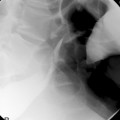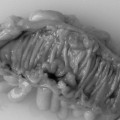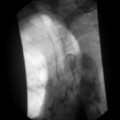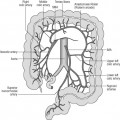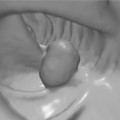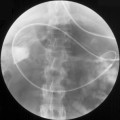CHAPTER 3 Introduction to patient preparation and pharmacology for gastrointestinal tract examinations
Introduction
The development of contrast media and patient preparations is interlinked with the development of image quality. As early as 1901, the use of air as a contrast medium was being discussed and single contrast meals became accepted practice in 1905. By 1917, the development of a reasonably reliable technique for imaging the colon meant that radiological descriptions of pathologies, such as carcinoma, tuberculosis, diverticulosis, megacolon and polyps, had been made. By the 1920s, it was stated that ‘the examination of the stomach and intestinal canal has become one of the most important spheres of radiographic work’ (Knox, 1923). Poor image quality limited the visualization of the gastrointestinal (GI) tract to more advanced pathologies such as strictures. Therefore, positive contrast studies predominated. However, with the improvements made in the 1960s in the detail available radiographically and fluoroscopically, the value of double contrast techniques was quickly advocated and became standard practice. It was quickly recognized that visualization of the mucosal lining of the GI tract was possible when using a double contrast technique and that the removal of artefacts within the system was essential to accurate diagnosis. As a result, a range of preparations and contrast media (positive and negative) has been developed and refined to support the requirement for increasingly high quality imaging, and an expanding variety of modalities and techniques are now used to visualize the GI tract.
This chapter discusses the principles of patient preparation and the pharmacology of preparations, contrast media and other pharmaceutical products currently used in the imaging of the GI tract.
Preparation
The earlier a GI abnormality is detected, the more the aim of treatment can be preventative rather than curative, and curative rather than palliative (National Institute for Clinical Excellence, 2004; Centre for Reviews and Dissemination, 2004). Maximizing diagnostic sensitivity and specificity in GI imaging is therefore a high priority. Diagnostic imaging is comprised of a series of events which are only ever as good as the weakest part of the process, making patient preparation as important a factor as any other. Diagnostic accuracy can be compromised by the presence of artefacts, such as food in the stomach or feces in the large bowel. These can mask or mimic pathology. It is therefore important that such artefacts are removed before an examination is carried out (Hendry et al., 2007; Pickhardt, 2007).
There are a number of important considerations when adopting a preparation regime. The process of clearance must leave the colon clean but not have any macro- or microscopic effects on the mucosa or compromise the patient’s physiology (Holte et al., 2004). For example, the action of a bowel preparation on the mucosal lining of the bowel can affect the adherence of the barium solution used (Cittadini et al., 1999a, 1999b). The need to review the contrast used should be taken into account when a regime is adopted or amended. Efficacy of the preparation needs to be balanced with patient compliance and acceptability in respect of taste, volume and action (Chan et al., 1997; Brown and DiPalma, 2004; Hendry et al., 2007). While it may be desirable to have a single regime for all patients from an administrative point of view, patients vary in their physical ability and comorbidities which need to be considered along with the adverse effects and contraindications of the agents used (Beloosesky et al., 2003; Sweetman, 2007; British Medical Association and the Royal Pharmaceutical Society of Great Britain, 2008). Finally, the financial cost of laxatives available varies considerably and poor preparation has been shown to have increased consequential costs (Bartram, 1994; Rex et al., 2002).
Getting the preparation regime right is important from the patient, clinician and service provider perspectives, as can be seen in Box 3.1. An appropriate bowel preparation regime can reduce both patient anxiety and the burden on the healthcare system.
The more distal in the GI tract the examination, the greater the patient preparation required. Little or none is required for examinations of the salivary glands, larynx, pharynx or esophagus (when imaged alone). For imaging the esophagus and stomach, generally a few hours’ dietary restriction is all that is required.
For small bowel imaging, preparation varies by imaging modality. For a fluoroscopic examination of the small bowel, the patient may require a laxative the day before and to have nothing to eat or drink for approximately eight hours prior to examination. For other imaging procedures such as computed tomography (CT) enteroclysis and capsule endoscopy, preparation may be more intensive (Paulsen et al., 2006; Rajesh and Maglinte, 2006; Van Tuyl et al., 2007; Kalantzis et al., 2007).
Laxatives
Bowel cleansing solutions are classed as laxatives but are not used in the treatment of constipation. They are specifically designed to ensure the bowel is free of solid contents prior to colonic surgery, colonoscopy and radiological examination. There are a variety of products commercially available and they all carry similar warnings and contraindications (Table 3.1).
Table 3.1 Risk factors and contraindications for bowel preparation
| Risk factors | Contraindication or caution advised | Potential risk |
|---|---|---|
| Pregnancy | Caution | Risks are unknown as there are no data evaluating the effects in pregnancy |
| Patients with heart disease and congestive cardiac failure | Caution | Hyperphosphatemia, hypocalcemia, hypernatremic dehydration and acidosis |
| Ulcerative colitis | Caution | Exacerbation of existing condition |
| Reflux esophagitis | Caution | Regurgitation or aspiration for oral examinations |
| Impaired gag reflex | Caution | Aspiration |
| Unconscious or semiconscious patients | Caution | Regurgitation or aspiration for oral examinations |
| Patients with renal impairment | Caution | Hyperphosphatemia, hypocalcemia, hypernatremic dehydration and acidosis |
| Pre-existing serious renal impairment | Contraindication | Renal failure |
| Gastrointestinal obstruction, gastric retention, ileus | Contraindication | Exacerbation of existing condition; perforation |
| Gastrointestinal ulceration, perforated bowel, toxic colitis, toxic megacolon | Contraindication | Exacerbation of existing condition; perforation |
Data from Russmann et al., 2007; Zuccaro et al., 2007; Sweetman, 2007; British Medical Association and the Royal Pharmaceutical Society of Great Britain, 2008; US FDA, 2008
Osmotic solutions work by increasing intestinal osmotic pressure, which encourages the retention of water in the large bowel. They include the saline laxatives, magnesium citrate, magnesium hydroxide and sodium sulfate and macrogols, such as polyethylene glycol (PEG) solutions. The saline laxatives draw fluid from the body into the bowel to provide a wash out effect, while the inert polymers of ethylene glycol work to retain in the bowel the fluid with which the solutions were administered. Example brand names for these solutions include, Citramag, Klean-Prep, GoLytely, MoviPrep; there are many more. Choice of laxative will depend on the examination to be performed, for example, colonoscopy can be successfully performed even if the mucosa is ‘wet’, whereas double contrast barium enema (DCBE) and CT colonography (CTC) would normally require a ‘dry’ colon (Bartram, 1994).
The principles of preparation for CT and magnetic resonance (MR) colonography remain essentially the same as for DCBE and colonoscopy. However, this is an area where optimal preparation, contrast and imaging are still rapidly evolving. Currently, in addition to diet and laxative preparation, fecal tagging is used in many centers. This allows differentiation of fecal remnants in the colon and involves the patient taking a positive contrast orally in advance of the examination (Taylor et al., 2008). Development work is focusing on minimizing discomfort for patients, which may eventually reduce the need for extensive bowel preparation for these examinations (Lefere et al., 2004; Zalis et al., 2006).
Preparation for CT proctography generally involves a dilute barium suspension taken orally one hour prior to examination to outline the small bowel, and glycerine suppositories to evacuate the rectum 20 minutes beforehand (Harvey et al., 1999).
Psychological and physical considerations of patient preparation
The main colonic imaging examinations, including barium enema, colonoscopy and computed tomography colonography, require bowel preparation. Efficacy of the preparation needs to be balanced with patient compliance and acceptability in respect of taste, volume and action. It is not feasible to ‘tailor’ a bowel preparation regime for individual patients; therefore, a standard regime to suit most bowel habits is generally used. However, any regime adopted will only ever be as good as the patients’ ability to understand and willingness to carry out the instructions for taking it. Issues for patients taking colon preparations include the complexity of preparing it, the taste and volume to be taken and the physical effects it has on them (potentially, this includes nausea, vomiting, bloating, cramps, headache, urgency and loss of sleep) (Gluecker et al., 2003).
Patients may already be anxious because they have symptoms that have made them visit a doctor and the expectation of pain and embarrassment of an examination of the GI tract may add to this. Detailed but concise written instructions should be provided in lay language for patients, together with details of what happens during the examination. Ideally, these should also be explained by the referring clinician to ensure the full cooperation of the patient (Department of Health, 2001). Once home with the preparation and instructions, patients often find questions they wish to ask, so contact details for someone who can answer queries and provide reassurance are essential.
Timing of preparation can affect patient experience. In a study comparing a preparation regime given in the morning to one group and the same given in the afternoon to another group, the preparation had similar efficacy when assessed overall. However, when the right side of the colon alone was assessed, preparation was significantly better in the morning group; the afternoon preparation was associated with loss of more working hours and sleep (Gupta et al., 2007).
Patient referral for a GI examination should include consideration not only of the clinical appropriateness of the test, taking into account the symptoms and potential risks from the test, but also from the physical and psychological perspective. Patients need to be capable of following the instructions, so special thought must be given to patients with a learning disability, English as a second language, ethnic or religious reasons why they may not be able and/or willing to undergo the examination after taking the prep (e.g. Muslim women wearing x-ray gown – male health professional undertaking the examination).
Stay updated, free articles. Join our Telegram channel

Full access? Get Clinical Tree










